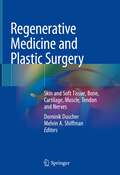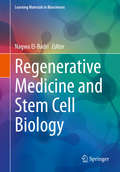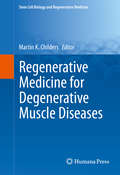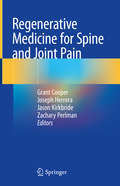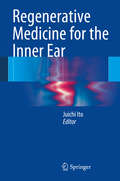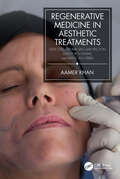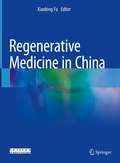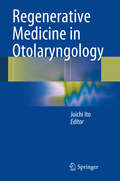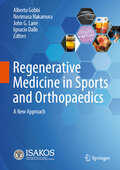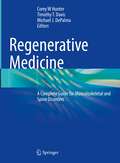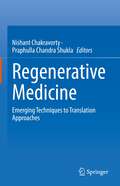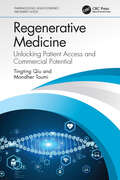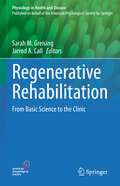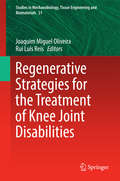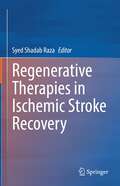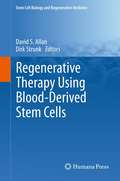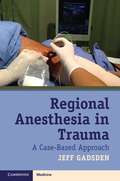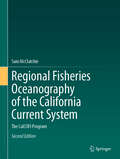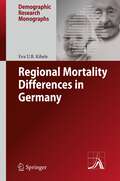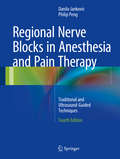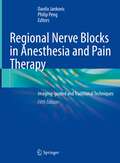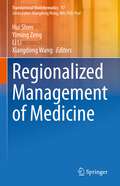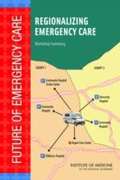- Table View
- List View
Regenerative Medicine and Plastic Surgery: Skin and Soft Tissue, Bone, Cartilage, Muscle, Tendon and Nerves
by Melvin A. Shiffman Dominik DuscherThis book presents the latest advances in the field of regenerative medicine in plastic surgery. It is the first authoritative reference documenting all the ways that plastic surgical practice and regenerative medicine science overlap or provide a road map for the future of both specialties. The Editors have provided a valuable service by gathering in one place the leading voices in these two fields in clear and concise manner.The first part introduces readers to essential principles of skin and soft tissue regeneration, e.g. the possibility of using mesenchymal stem cells for wound healing. Since bone serves as a supportive tissue in most of the body, bone regeneration is an important aspect of regenerative medicine; accordingly, the second part discusses the novel bone implants, activated bone grafts and bone tissue engineering. The book’s third part, focusing on cartilage regeneration, includes chapters on e.g. stem cells and ear regeneration. In turn, part four addresses muscle and tendon regeneration: from tendon to bone and tendon to muscle, as well as aging in the realm of muscle regeneration. Lastly, part five highlights nerve regeneration, deepening surgeons’ knowledge to help them successfully treat injuries to the peripheral neural system. Written by leading experts this book is an invaluable resource for researchers, students, beginners and experienced clinicians in a range of specialties."With beautiful clinical images and artwork, this book will be a central companion to both practicing plastic surgeons who wish to remain abreast of oncoming technologic advances and regenerative medicine researchers who wish to understand the current state of the art of surgical reconstruction." - Geoffrey C. Gurtner, MD, FACS Johnson and Johnson Distinguished Professor of Surgery Professor (by courtesy) of Bioengineering and Materials Science Inaugural Vice Chairman of Surgery for Innovation Stanford University School of Medicine
Regenerative Medicine and Stem Cell Biology: Bench To Bedside (Learning Materials in Biosciences #0)
by Nagwa El-BadriThis textbook covers the basic aspects of stem cell research and applications in regenerative medicine. Each chapter includes a didactic component and a practical section. The book offers readers insights into: How to identify the basic concepts of stem cell biology and the molecular regulation of pluripotency and stem cell development. How to produce induced pluripotent stem cells (iPSCs) and the basics of transfection. The biology of adult stem cells, with particular emphasis on mesenchymal stromal cells and hematopoietic stem cells, and the basic mechanisms that regulate them. How cancer stem cells arise and metastasize, and their properties. How to develop the skills needed to isolate, differentiate and characterize adult stem The clinical significance of stem cell research and the potential problems that need to be overcome. Evaluating the use of stem cells for tissue engineering and therapies (the amniotic membrane) The applications of bio-nanotechnology in stem cell research. How epigenetic mechanisms, including various DNA modifications and histone dynamics, are involved in regulating the potentiality and differentiation of stem cells. The scientific methods, ethical considerations and implications of stem cell research.
Regenerative Medicine for Degenerative Muscle Diseases
by Martin K. ChildersThis book compiles andexplores cutting-edge research in degenerative skeletal disorders, such asDuchenne muscular dystrophy and congenital myopathy, and new stem-cell basedtherapies and gene replacement therapy. Twelve expertly-authored chapters navigatethe nuances of these treatments in an array of contexts and biological systems. The topics covered include: How are urine cells from a patient with Duchennemuscular dystrophy transformed into beating heart cells? What can reprogrammedcells tell us about heart muscle failure? What do gene mutations mean for thoseborn with a muscle disease? How are manufacturing methods applied to human stemcells? Does therapeutic exercise benefit those patients who receive engineeredlimb muscle? Is there practical advice about nutrition to enhance musclefunction for the Duchenne patient? Can microRNAs be useful to regeneratediseased muscle? RegenerativeMedicine for Degenerative Muscle Diseases is ideal for scientistsand clinicians from varying disciplines in genetics, cell biology, virology,cell-based manufacturing, rehabilitation medicine, nutrition, veterinarymedicine and neurosurgery. The reader will see how transformative changes occurin medicine that can powerfully impact the future for patients suffering frominherited disorders affecting muscles of the body, including the heart.
Regenerative Medicine for Spine and Joint Pain
by Grant Cooper Joseph Herrera Jason Kirkbride Zachary PerlmanRegenerative medicine (RM) is a rapidly expanding topic within orthopedic and spine surgery, sports medicine and rehabilitation medicine. In the last ten years, regenerative medicine has emerged from the fringes as a complement and challenge to evidence-based medicine. Both clinicians and patients alike are eager to be able to offer and receive treatments that don't just surgically replace or clean old joints or inject away inflammation or work as a stop-gap measure. Regenerative medicine encompasses everything from the use of stem cells and platelet-rich plasma (PRP) to prolotherapy, viscosupplementation and beyond. This book will provide healthcare practitioners dealing with spine and joint pain with the most current, up-to-date evidence-based information about which treatments work, which treatments don't, and which are on the horizon as potential game changers. Chapters are arranged in a consistent format and cover the spine, shoulder, elbow, hand and wrist, hip, knee, and foot and ankle, providing a thorough, top-to-bottom approach. A concluding chapter discusses current and future directions and applications of RM over the next decade or two.Timely and forward-thinking, Regenerative Medicine for Spine and Joint Pain will be a concise and practical resource for orthopedists, spine surgeons, sports medicine specialists, physical therapists and rehabilitation specialists, and primary care providers looking to expand their practice.
Regenerative Medicine for the Inner Ear
by Juichi ItoThe research described in this book represents important steps toward understanding the development of inner ear medicine and new perspectives in regenerative medicine, including efficacy in cochlear implants and various other treatments. The book depicts the mechanisms that underlie inner ear diseases, their experimental models, and proposals for new strategies to treat their symptoms. As well, the exciting future prospects for dealing with the very common problem of inner ear diseases are explained. These disorders occur among many people and include sensorineural hearing loss (SNHL), sudden deafness, senile deafness, noise-induced deafness, tinnitus, dizziness-vertigo, and Ménière's disease. In Japan alone, there are more than 6 million deaf patients including those with middle-range deafness. There is currently no effective treatment, and regardless of the underlying cause, the damage has been considered irreversible. However, the results of recent research show that these patients actually can recover. The study of hair cells, spiral ganglion neurons, and stem cells for inner ear diseases such as SNHL, tinnitus, dizziness, and vertigo is at the forefront of regenerative medicine and may provide solutions to some of these problems. The information presented here makes this book a valuable professional reference work for all doctors and researchers in the field of otolaryngology who focus on regenerative treatments for inner ear diseases.
Regenerative Medicine in Aesthetic Treatments: Stem Cells, Stromal Vascular Fraction, Platelet Rich Plasma, and Platelet Rich Fibrin
by Aamer KhanPhysicians are now in a position pro-actively to use stem cells and their growth factors to regenerate the human body. Within the field of aesthetics, regenerative medicine is being used to reverse the ageing of tissues and to repair scarring to an unprecedented level. This highly illustrated text from an internationally recognized expert in cosmetic procedures documents the procedures and results for patients.
Regenerative Medicine in China
by Xiaobing FuThis book includes major issues in wound tissue repair and regeneration in 14 chapters. The topics start from cytological basis, molecular and genetic basis, skin development, to the tissue repair, visceral injury and tissue engineering. In the second part, it introduces Chinese researchers’ contribution in wound repair and regeneration. Specially, it has 3 chapters discussing new technologies in tissue repair and regeneration, and 1 chapter in Traditional Chinese Medicine.
Regenerative Medicine in Otolaryngology
by Juichi ItoThis book describes an exciting new movement using regenerative medicine to treat patients with otolaryngological diseases. The emerging field of regenerative medicine uses tissue engineering, which combines medicine and engineering not only to treat the diseases themselves but also to enable recovery of the function of affected areas. As otolaryngology covers wide regions, including many diseases of the head and neck, the book is divided into sections, each corresponding to a different anatomical structure -- the ear, nose, oral cavity, pharynx, larynx and head and neck. The structural developments of each region, the underlying mechanisms of diseases specific to these regions, their experimental models and proposals for new regenerative treatment are all discussed in detail. The various diseases and symptoms considered in the book include inner ear and middle ear diseases, rhinitis, nasal sinusitis and otolaryngological cancers. To date there have been few clinical studies reporting regenerative medical applications in the field of otolaryngology, but in this volume leading authors present the latest research findings to help provide new therapies for patients in the future. This state-of-the-art information makes the book a valuable professional reference work for all doctors and researchers who focus on regenerative treatments in the field of otolaryngology and neuroscience.
Regenerative Medicine in Sports and Orthopaedics: A New Approach
by Alberto Gobbi Norimasa Nakamura John G. Lane Ignacio DalloThis book offers a comprehensive overview of the rapidly evolving field of regenerative medicine, including key breakthroughs in clinical therapies. It is further aimed at facilitating ethical, high-quality research in Sports Medicine and Orthopaedics. Set apart by its unique structure, it bridges the gap between basic science and practical applications. Divided into three distinct sections, it begins by laying a strong foundation, delving into the biological and molecular underpinnings of regenerative medicine, including stem cells, growth factors, gene editing, tissue engineering, nanotechnology, and bio-manufacturing. The second section takes readers on a journey into the clinical applications of regenerative medicine, offering valuable guidance and insights for practitioners. The third section, dedicated to future trends and bio-materials&’ applications, sheds new light into the evolving landscape of this field. By providing a structured, comprehensive, and up-to-date resource, it equips researchers, clinicians, residents and students with the knowledge needed to make a positive impact in this ever-expanding domain. Written in collaboration with ISAKOS, this volume serves as an invaluable tool in advancing readers&’ understanding and practice in the field.
Regenerative Medicine: A Complete Guide for Musculoskeletal and Spine Disorders
by Michael J. DePalma Corey W Hunter Timothy T. DavisThis book explores the rapidly growing subspecialty of regenerative medicine in pain management. It provides concise guidelines and instruction for healthcare providers interested in implementing this novel therapy. The book contains three sections and begins with a thorough introduction to the field. Additionally, section one examines various therapies such as stem cell collection, allograft therapies, and bone marrow aspirations. Section two then delves into the medical diagnosis and procedural guidance methods, including ultrasound imaging, discography, local anesthetics, and anticoagulation medications. Following this, section three concludes the book with numerous discussions on standardized treatment paradigms. A unique, first-of-its-kind book, Regenerative Medicine seeks to inspire medical practitioners to integrate this subspecialty into pain management therapies and treatments.
Regenerative Medicine: Emerging Techniques To Translation Approaches
by Nishant Chakravorty Praphulla Chandra ShuklaThis book focuses on the recent innovations and therapeutic potentials of regenerative medicine and discusses the applications of stem cells, biomaterials, and tissue engineering in regenerative medicine. The book covers essential aspects of regenerative medicine, including tissue microenvironment, immunological perspectives, stem, and non-stem cell-mediated approaches, imaging techniques, biomarkers, and 3D printing technology. It also reviews the applications of biosensing technologies in regenerative medicine, including biomanufacturing, organ-on-a-chip technologies, and as indicators of therapeutic efficacy. Further, it focuses on the regenerative medicine approaches for diseases of the central nervous system. It also provides the therapeutic potential of regenerative medicine to improve soft tissue and wound healing, cardiovascular, neural, bone, and orofacial regeneration.
Regenerative Medicine: Emerging Techniques to Translation Approaches
by Nishant Chakravorty Praphulla Chandra ShuklaThis book focuses on the recent innovations and therapeutic potentials of regenerative medicine and discusses the applications of stem cells, biomaterials, and tissue engineering in regenerative medicine. The book covers essential aspects of regenerative medicine, including tissue microenvironment, immunological perspectives, stem, and non-stem cell-mediated approaches, imaging techniques, biomarkers, and 3D printing technology. It also reviews the applications of biosensing technologies in regenerative medicine, including biomanufacturing, organ-on-a-chip technologies, and as indicators of therapeutic efficacy. Further, it focuses on the regenerative medicine approaches for diseases of the central nervous system. It also provides the therapeutic potential of regenerative medicine to improve soft tissue and wound healing, cardiovascular, neural, bone, and orofacial regeneration.
Regenerative Medicine: Unlocking Patient Access and Commercial Potential (Pharmaceuticals, Health Economics and Market Access)
by Mondher Toumi Tingting QiuA comprehensive review of the challenges that exist in patient accessibility to regenerative medicines (RMs), presenting clinical trials, marketing authorization, HTA, pricing, reimbursement, affordability, payment and partnership agreements of RMs and commercialization. Specfically, we investigated how COVID-19 has impacted the RM industry by elaborating on the disruptions it caused but also the new opportunities it brought. The ultimate goal of this work is to make strategic recommendations for manufacturers and decisions-makers on effective strategies to address the above obstacles and facilitate patient access to promising regenerative medicines.FEATURES Regenerative medicine (RM) is an emerging interdisciplinary field aiming to replace or regenerate human cells, tissues, or organs in order to restore normal function. RM holds the promise of revolutionizing treatment in the 21st century. RMs bring new hope for some previously untreatable diseases, as well as holding promise for the treatment of common chronic diseases. Rapid advancements in biotechnology and improved understanding of disease pathophysiology have attracted tremendous interests in the development of RMs. Discusses the high cost of RMs which may challenge the sustainability of healthcare insurers (public and private).
Regenerative Pharmacology
by George J. Christ Karl-Erik AnderssonRegenerative medicine is broadly defined as the repair or replacement of damaged cells, tissues, and organs. It is a multidisciplinary effort in which technologies derive from the fields of cell, developmental, and molecular biology; chemical and material sciences (i. e. , nanotechnology); engineering; surgery; transplantation; immunology; molecular genetics; physiology; and pharmacology. As regenerative medicine technologies continue to evolve and expand across the boundaries of numerous scientific disciplines, they remain at the forefront of the translational research frontier with the potential to radically alter the treatment of a wide variety of disease and dysfunction. The goal of this book is to draw attention to the critical role that the pharmacological sciences will undeniably play in the advancement of these treatments. This book is invaluable for advanced students, postdoctoral fellows, researchers new to the field of regenerative medicine/tissue engineering, and experienced investigators looking for new research avenues. This is the first state-of-the-art book in this rapidly evolving field of research.
Regenerative Rehabilitation: From Basic Science to the Clinic (Physiology in Health and Disease)
by Sarah M. Greising Jarrod A. CallThis contributed volume presents the current state of research on regenerative rehabilitation across a broad range of neuro- and musculoskeletal tissues. At its core, the primary goal of regenerative rehabilitation is to restore function after damage to bones, skeletal muscles, cartilage, ligaments/tendons, or tissues of the central and peripheral nervous systems. The authors describe the physiology of these neuro- and musculoskeletal tissue types and their inherent plasticity. The latter quality is what enables these tissues to adapt to mechanical and/or chemical cues to improve functional capacity. As a result, readers will learn how regenerative rehabilitation exploits that quality, to trigger positive changes in tissue function. Combining basic, translational, and clinical aspects of the topic, the book offers a valuable resource for both scientists and clinicians in the regenerative rehabilitation field.
Regenerative Strategies for the Treatment of Knee Joint Disabilities
by Joaquim Miguel Oliveira Rui Luís ReisThis book presents regenerative strategies for the treatment of knee joint disabilities. The book is composed of four main sections totaling 19 chapters which review the current knowledge on the clinical management and preclinical regenerative strategies. It examines the role of different natural-based biomaterials as scaffolds and implants for addressing different tissue lesions in the knee joint. Section one provides an updated and comprehensive discussion on articular cartilage tissue regeneration. Section two focuses on the important contributions for bone and osteochondral tissue engineering. Section three overview the recent advances on meniscus repair/regeneration strategies. Finally, section four further discusses the current strategies for treatment of ligament lesions. Each chapter is prepared by world know expert on their fields, so we do firmly believe that the proposed book will be a reference in the area of biomaterials for regenerative medicine.
Regenerative Therapies in Ischemic Stroke Recovery
by Syed Shadab RazaThis book illustrates the importance and significance of regenerative medicine in stroke recovery. It discusses stem-cell-based treatment strategies and offers mechanistic insights into their role in neurological recovery. It also examines the challenges and advances in using adult stem cells for enhanced therapeutic efficacy. Further, it presents the strategies as well as the strengths and weaknesses of various delivery methods to administer stem cells in ischemic stroke. It examines the role of non-coding RNA in our understanding the stroke pathogenesis, their regulatory role in ischemic stroke and potential as biomarkers and therapeutic targets. Lastly, it explores exosomes in the treatment of stroke, and the underlying mechanism of their action as therapeutic vectors for stroke. Given its scope, it is an excellent resource for neurologists, neuroscientists and researchers involved in regenerative therapy for stroke.
Regenerative Therapy Using Blood-Derived Stem Cells
by David S. Allan Dirk StrunkBlood has long been viewed as a conduit for therapy, stemming from the ancient days of phlebotomy to remove evil humors to the development of successful blood transfusions to replace missing blood components. The identification and characterization of hematopoietic stem cells by Drs. Till and McCulloch revolutionized the field and soon after, non-hematopoietic stem and progenitor cells were characterized from the blood and bone marrow. Some of these cell types and various blood-derived cell lineages are involved in the repair of various types of tissue damage that span the spectrum of medical disorders. The goal of this book is to provide an up-to-date review of the various types of blood-derived cells with regenerative capacity, identify opportunities for intervention by examining specific clinical applications, and recognize the regulatory environment that will encompass future therapies in regenerative medicine.
Regional Anesthesia in Trauma
by Jeff GadsdenThe management of pain from acute injuries is a priority in trauma care. Regional analgesic techniques are very effective at treating acute pain and are gaining in popularity as recognition of their beneficial effects on morbidity increases. Regional Anesthesia in Trauma employs multiple narrative problem-solving case scenarios that explore the use of regional anesthesia in: * Blunt chest trauma, amputations, upper and lower extremity fractures and spinal injury * Burn injury * Patients with pre-existing nerve injury and other co-morbidities * Patients at risk for compartment syndrome * Pregnant, obese, elderly and pediatric patients * Local anesthetic systemic toxicity With a focus on ultrasound-guided techniques, the reader is guided through the technical aspects of performing regional anesthesia as well as the medical and surgical considerations that influence the choice of analgesic therapy. Regional Anesthesia in Trauma is invaluable for practitioners and trainees in anesthesiology, emergency medicine and trauma surgery.
Regional Fisheries Oceanography of the California Current System: The CalCOFI Program
by Sam McClatchieThe California Current System is one of the best studied ocean regions of the world, and the level of oceanographic information available is perhaps only surpassed by the northeast and northwest Atlantic. The current literature (later than 1993) offers no comprehensive, integrated review of the regional fisheries oceanography of the California Current System. This volume summarizes information of more than 60-year California Cooperative Oceanic Fisheries Investigation (CalCOFI). While providing a large bibliography, the intent was to extract themes relevant to current research rather than to prepare a compendious review of the literature. The work presents a useful review and reference point for multidisciplinary fisheries scientists and biological oceanographers new to working in the California Current System, and to specialists wishing to access information outside their core areas of expertise. In addition, the first editioin published in 2014 aimed to deliver an up to date reference to the current state of knowledge of fisheries oceanography in the California Current System. The second edition adds some new sections, and data visualizations. The most important new material is included in the perspectives on CalCOFI chapter. New vignettes have been added for Reuben Lasker, Ed Brinton, Abraham Fleminger, Elizabeth Venrick, and Andrew Leising. The vignette for Noelle Bowlin has been updated to reflect her position as the current NOAA lead for the CalCOFI program, and a vignette has also been added for Sam McClatchie.
Regional Mortality Differences in Germany
by Eva U.B. KibeleRegional mortality differences are one dimension of health inequalities, but its trends and determinants in Germany are widely unknown. This book examines and illustrates patterns of regional mortality in Germany--with focus on small-area differentials--and their changes over time. It identifies explanatory factors at individual and regional level. Mortality differences between eastern and western Germany exist, but small-area mortality differentials are often greater. Though the main spatial mortality patterns remain, this study provides evidence that some distinct changes in the small-area mortality patterns in Germany--especially among women--occurred within a short period of time. Mortality inequalities at younger ages and in behavior-related causes as well as differences in socioeconomic conditions contribute strongly to regional mortality differences in Germany. The book shows that the complex interplay between individual- and regional-level mortality risk factors requires a multidimensional approach to reduce regional mortality inequalities.
Regional Nerve Blocks in Anesthesia and Pain Therapy
by Danilo Jankovic Philip PengIn recent years the field of regional anesthesia, in particular peripheral and neuraxial nerve blocks, has seen an unprecedented renaissance following the introduction of ultrasound-guided regional anesthesia. This comprehensive, richly illustrated book discusses traditional techniques as well as ultrasound-guided methods for nerve blocks and includes detailed yet easy-to-follow descriptions of regional anesthesia procedures. The description of each block is broken down into the following sections: definition; anatomy; indications; contraindications; technique; drug choice and dosage; side effects; potential complications and how to avoid them; and medico-legal documentation. A checklist record for each technique and a wealth of detailed anatomical drawings and illustrations offer additional value. Regional Nerve Blocks in Anesthesia and Pain Medicine provides essential guidelines for the application of regional anesthesia in clinical practice and is intended for anesthesiologists and all specialties engaged in the field of pain therapy such as pain specialists, surgeons, orthopedists, neurosurgeons, neurologists, general practitioners, and nurse anesthetists.
Regional Nerve Blocks in Anesthesia and Pain Therapy: Imaging-guided and Traditional Techniques
by Danilo Jankovic Philip PengThis comprehensive atlas, which includes a wealth of illustrations and anatomic pictures created by the editors, covers a broad range of both regional anesthesia and pain intervention techniques, including neuromodulation. The book is unique in that it covers ultrasound and fluoroscopic-guided techniques, as well as traditional landmark-guided techniques. The authors and editors are internationally renowned experts, and share extensive theoretic and practical insights into regional anesthesia, pain therapy and anatomic sciences for everyday practice.The book addresses the application of ultrasound and fluoroscopic guidance for pain interventions and provides detailed coverage of ultrasound-guided and landmark-guided regional anesthesia. The book represents a detailed guide to the application of regional anesthesia and pain medicine; furthermore, examples of medico-legal documentation are also included in this edition. The 5th edition of Regional Nerve Blocks in Anesthesia and Pain Medicine is practically oriented and provides essential guidelines for the clinical application of regional anesthesia. It is intended for anesthesiologists and all professionals engaged in the field of pain therapy such as pain specialists, surgeons, orthopedists, neurosurgeons, neurologists, general practitioners, and nurse anesthetists.
Regionalized Management of Medicine (Translational Bioinformatics #17)
by Li Li Xiangdong Wang Yiming Zeng Hui ShenThe Book mainly focuses on various aspects of regionalized management of medicine, related with updates of new biotechnology, application of therapeutic strategy, and understanding of disease-associated molecular mechanisms. The book also discusses how medical informatics, systems analysis, database sharing, and artificial intelligent can be applied for improving the quality of hospital managements, disease therapies, regional collaborations, and medical services. This book serves as a professional reference book to clinicians and experts who are interested in medical informatics and artificial intelligence for diseases therapies and therapeutic strategy, better systems analysis and database sharing, and more efficient regional collaborations and medical services.
Regionalizing Emergency Care: Workshop Summary
by Institute of Medicine of the National AcademiesDuring medical emergencies, hospital staff and emergency medical services (EMS) providers, can face barriers in delivering the fastest and best possible care. Overcrowded emergency rooms cannot care for patients as quickly as necessary, and some may divert ambulances and turn away new patients outright. In many states, ambulance staff lacks the means to determine which hospitals can provide the best care to a patient. Given this absence of knowledge, they bring patients to the closest hospital. In addition, because emergency service providers from different companies compete with each other for patients, and emergency care legislation varies from state to state, it is difficult to establish the necessary local, interstate, and national communication and collaboration to create a more efficient system. In 2006, the IOM recommended that the federal government implement a regionalized emergency care system to improve cooperation and overcome these challenges. In a regionalized system, local hospitals and EMS providers would coordinate their efforts so that patients would be brought to hospitals based on the hospitals' capacity and expertise to best meet patients' needs. In September 2009, three years after making these recommendations, the IOM held a workshop sponsored by the federal Emergency Care Coordination Center to assess the nation's progress toward regionalizing emergency care. The workshop brought together policymakers and stakeholders, including nurses, EMS personnel, hospital administrators, and others involved in emergency care. Participants identified successes and shortcomings in previous regionalization efforts; examined the many factors involved in successfully implementing regionalization; and discussed future challenges to regionalizing emergency care. This document summarizes the workshop.
